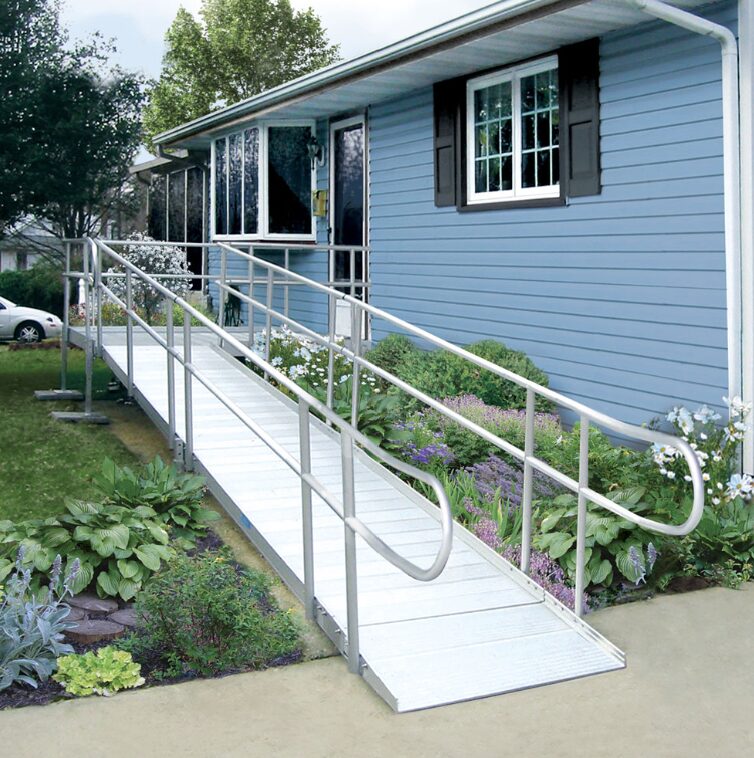Creating a wheelchair-accessible home ensures safety, comfort, and independence for people with mobility challenges. Although it may seem like a daunting project, you can make your home more wheelchair accessible with thoughtful modifications that don’t necessarily require costly structural changes.
Ramps and Lifts
An essential modification for making a home wheelchair accessible is to add ramps over stairs, curbs, and other uneven surfaces to allow a smooth transition in and out of the home or between levels. Ramps can be permanent additions, modular for portable accessibility, or foldable for easy storage. Work with a wheelchair ramp professional to help you choose the right type for different areas of your home and ensure they’re compliant with the Americans With Disabilities Act.
Lifts offer a practical alternative for homes with significant elevation changes or limited space. Vertical platform lifts or stair lifts can transport people between floors without the need for extensive renovations. Stair lifts are convenient in multistory homes and are usually installed along staircases for easy access to upper levels. These devices support independence and make it easier for wheelchair users to navigate their homes without assistance.
Bathroom Accessibility
Bathrooms can be adapted for wheelchair use with easy-to-install accessories that make the space functional and safe.
Grab bars installed around the shower, tub, and toilet will aid with sitting, standing, and balance. Whether they’re used by adults or children, properly installed grab bars should accommodate at least 250 pounds. They may also need to be reinforced to the wall to be ADA compliant.
A curbless, roll-in shower provides step-free access for a wheelchair user to get into the shower from a chair. Install a handheld showerhead on an adjustable bar for convenience. Most wheelchairs aren’t intended for shower use, so seating is key for accessibility. A stationary shower chair or fold-down, wall-mounted bench will provide extra support and stability.
The ADA recommends toilets have a seat height of 17 to 19 inches. There are several ways to increase toilet height including purchasing a taller toilet or installing a thicker seat on your existing toilet.
Ideally, the sink should have open space underneath for a wheelchair, and the faucet should be easy to operate, with lever handles or a touchless design.
Wider Doorways
Standard interior doors typically measure anywhere from 23 to 32 inches wide, depending on the age of the home. To accommodate a wheelchair, doorways should be a minimum of 32 inches wide, but 36 inches is ideal for most wheelchairs to pass comfortably.
Depending on the size of the existing doorway, widening it may entail removing the door and surrounding trim, adjusting or replacing the door frame, and reframing the surrounding wall. In some cases, you may be able to replace the current door with a pocket door or barn door to save space.
Another option is to replace traditional door hinges with offset or swing-clear hinges. These Z-shaped hinges allow a door to swing completely out of a doorway when opened, creating more clearance without needing structural changes.
In addition to wider doorways, consider modifying door thresholds so they are level against the floor or installing low-profile thresholds to ensure a wheelchair can roll through a doorway easily without getting stuck.
Kitchen Adjustments
The kitchen is often the most challenging room for wheelchair access, usually because of space limitations, countertops, and appliances.
Countertops should be no deeper than 30 inches. Standard countertops are typically 36 inches high, but lowering them to 28 or 34 inches provides easier access. Not all countertop spaces need to be lowered. In some cases, lowering only certain sections is an adequate solution. Keep space open underneath the sink, countertops, and cooking area for a wheelchair to roll under.
Select appliances that can be raised or lowered for accessibility. Lowering appliances to a maximum of 31 inches is ideal, although some dishwashers may need to be raised by 6 inches for optimal accessibility. Many, though not all, items in a full-size, side-by-side refrigerator are easier to reach from a seated position.
Store frequently used items 15 to 48 inches from the floor in low-level drawers, shelves, or pull-out baskets. Install a pull-out faucet sprayer in the sink for additional flexibility.
Wheelchair-Friendly Outdoor Spaces
Making outdoor spaces wheelchair friendly requires safe access and ease of movement. Accessing the outdoors from inside a home may require the addition of threshold ramps or a sliding door onto a level surface, such as a patio or walkway.
Uneven materials, such as gravel, mulch, and grass, are difficult to navigate in a wheelchair. Paths should be 36 inches wide with a slip-resistant surface, such as concrete, asphalt, or pavers.
Outdoor furniture should be solid and sturdy and placed so that pathways are clear and easy to navigate. Pedestal-style tables provide comfortable knee space for outdoor dining.
Garden areas can be made more accessible by using raised garden beds, typically 24 to 30 inches high, which allow a wheelchair user to tend to plants without bending or reaching too far.
Ensure that outdoor lighting is adequate for visibility at night, promoting safety and security in all accessible areas.
Whether you’re shopping with a real estate agent for an accessible home, or you need to adapt your current space, making your home wheelchair accessible doesn’t necessarily demand a full-scale remodel — just thoughtful consideration of a user’s needs. Incorporating even small changes can create a home environment that is welcome to all and promotes ease of mobility, safety, and independence.
Designing Open Floor Plans: How to Maximize Mobility and Accessibility for Aging Adults
Make Home Safe: How to Retrofit Your Home for Accessibility
Inclusive Design: Making Your Home Accessible for Children of All Abilities






